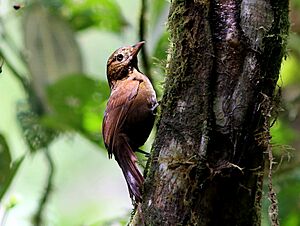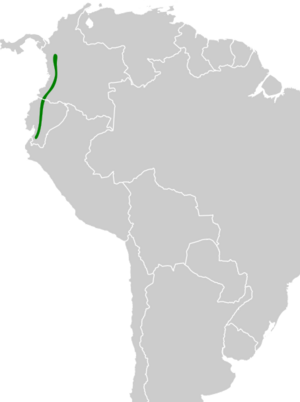Uniform treehunter facts for kids
Quick facts for kids Uniform treehunter |
|
|---|---|
 |
|
| Conservation status | |
| Scientific classification | |
| Genus: |
Thripadectes
|
| Species: |
ignobilis
|
 |
|
The uniform treehunter (Thripadectes ignobilis) is a type of bird. It belongs to the ovenbird family, called Furnariidae. You can find this bird in Colombia and Ecuador.
Contents
About the Uniform Treehunter
The uniform treehunter is closely related to two other birds. These are the flammulated treehunter and the Peruvian treehunter. Scientists call them "sister species" because they share a common ancestor. This bird is also "monotypic," meaning it's the only species in its group.
What Does It Look Like?
The uniform treehunter is about 19 to 20 cm (7.5 to 7.9 in) long. It weighs between 48 and 51 g (1.7 and 1.8 oz). This bird is the smallest and darkest of its kind. It also has the shortest beak in its group. Both male and female birds look the same.
Adult uniform treehunters have a faint, narrow stripe above their eye. They also have a wide ring around their eye. These parts are a dull, reddish-brown color. Their cheeks are dark brown with lighter streaks. The top of their head is dark brown with light spots.
Their back and rump are a bit lighter and more reddish. Their wings and tail are a rich, dark reddish-brown. The throat is a dull, dark buff color with wide, blurry streaks. Their chest and belly are rich, dark brown with thin buff streaks. These streaks fade towards the back.
Their eyes are dark brown. The upper part of their beak is dark brownish. The lower part is blackish with a reddish base. Their legs and feet are greenish-brown.
Where Does It Live?
The uniform treehunter lives on the Pacific side of the Andes mountains. You can find it from the Western Andes in Chocó Department, Colombia. Its range goes south through Ecuador to El Oro Province.
This bird lives in mountain evergreen forests. It also lives in secondary forests. These are forests that have grown back after being cut down. It prefers subtropical and foothill areas. In Colombia, it mostly lives between 500 and 2,500 m (1,600 and 8,200 ft) high. In Ecuador, it is usually found between 1,000 and 1,700 m (3,300 and 5,600 ft) high.
Sometimes, it can be found as low as 500 m (1,600 ft) in both countries. In Ecuador, it can sometimes be seen as high as 2,500 m (8,200 ft).
How It Behaves
Movement
The uniform treehunter stays in the same area all year round. It does not migrate.
Feeding Habits
This bird eats arthropods, which are creatures like insects and spiders. It usually hunts alone. However, it often joins groups of different bird species that are feeding together. It mostly looks for food in thick plants close to the ground. But it also searches higher up in the middle parts of the forest. It finds prey by picking it off branches, dead leaves, and other debris.
Reproduction
Scientists do not know much about the uniform treehunter's nesting season. They know it happens at least from June to September. It is thought that these birds stay with one partner for life. They build their nests in tunnels dug into earthen banks. Not much else is known about how they raise their young.
Vocalization
The uniform treehunter's song is a high-pitched sound. It is a series of six to eight sharp "kik" or "kyip" notes.
Conservation Status
The IUCN (International Union for Conservation of Nature) has listed the uniform treehunter as "Least Concern." This means it is not currently in danger of disappearing. It lives in a specific area, and its population size is unknown. However, experts believe its numbers are stable. No immediate threats have been found for this bird. It is considered uncommon to fairly common in some places. It also lives in two protected areas in Colombia.


